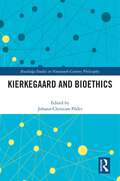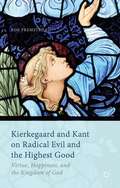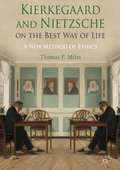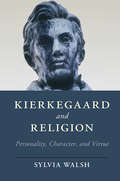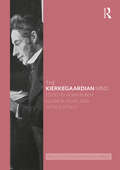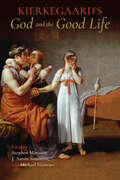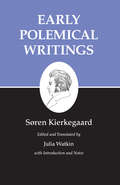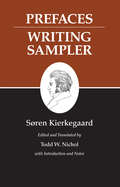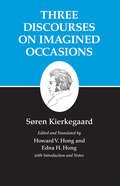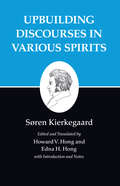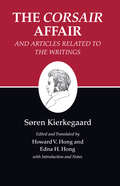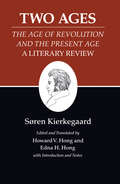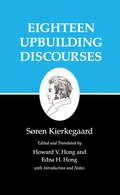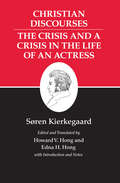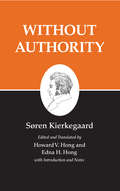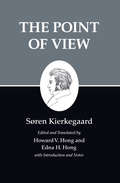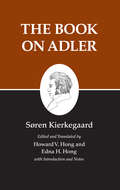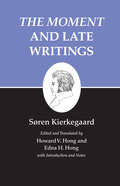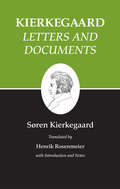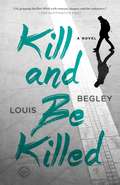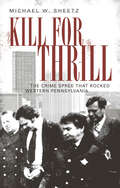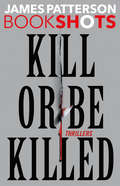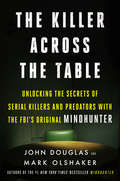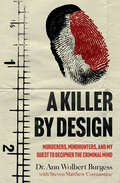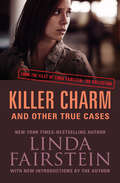- Table View
- List View
Kierkegaard and Bioethics (Routledge Studies in Nineteenth-Century Philosophy)
by Johann-Christian PõderThis book explores Kierkegaard’s significance for bioethics and discusses how Kierkegaard’s existential thinking can enrich and advance current bioethical debates.A bioethics inspired by Kierkegaard is not focused primarily on ethical codes, principles, or cases, but on the existential 'how' of our medical situation. Such a perspective focuses on the formative ethical experiences that an individual can have in relation to oneself and others when dealing with medical decisions, interventions, and information. The chapters in this volume explore questions like: What happens when medicine and bioethics meet Kierkegaard? How might Kierkegaard’s writings and thoughts contribute to contemporary issues in medicine? Do we need an existential turn in bioethics? They offer theoretical reflections on how Kierkegaard’s existential thinking might contribute to bioethics and apply Kierkegaardian concepts to debates on health and disease, predictive medicine and enhancement, mental illness and trauma, COVID-19, and gender identity.Kierkegaard and Bioethics will be of interest to scholars and advanced students working on Kierkegaard, bioethics, moral philosophy, existential ethics, religious ethics, and the medical humanities.
Kierkegaard and Kant on Radical Evil and the Highest Good
by Roe FremstedalKierkegaard and Kant on Radical Evil and the Highest Good is a major study of Kierkegaard's relation to Kant that gives a comprehensive account of radical evil and the highest good, two controversial doctrines with important consequences for ethics and religion. Fremstedal offers an original account of Kierkegaard and his role in the history of philosophy that reconstructs several of his central ideas by relating them to Kant and partially also to contemporary debates. By offering a comparative presentation, the book shows how Kant and Kierkegaard offer different accounts of evil and its complex relations to religious faith and happiness. Fremstedal sheds new light on Kierkegaard's argument against secular thinking, and shows that there are more Kantian elements in Kierkegaard than has been acknowledged. Kierkegaard's use of Kantian ideas is instructive, since it points to problems with Kant's philosophy of religion and indicates how Kantian philosophy can be used to defend religious faith and hope.
Kierkegaard and Nietzsche on the Best Way of Life
by Thomas P. MilesKierkegaard and Nietzsche revive an ancient approach to ethics that evaluates different ways of life considered as a whole. Comparing and contrasting their respective ideals of faith and individual sovereignty, this work reveals a valuable new path for contemporary ethics.
Kierkegaard and Religion: Personality, Character, And Virtue (Cambridge Studies In Religion, Philosophy And Society )
by Sylvia WalshNo thinker has reflected more deeply on the role of religion in human life than Søren Kierkegaard, who produced in little more than a decade an astonishing number of works devoted to an analysis of the kind of personality, character, and spiritual qualities needed to become an authentic human being or self. <p><p>Understanding religion to consist essentially as an inward, passionate, personal relation to God or the eternal, Kierkegaard depicts the art of living religiously as a self through the creation of a kaleidoscope of poetic figures who exemplify the constituents of selfhood or the lack thereof. The present study seeks to bring Kierkegaard into conversation with contemporary empirical psychology and virtue ethics, highlighting spiritual dimensions of human existence in his thought that are inaccessible to empirical measurement, as well as challenging on religious grounds the claim that he is a virtue ethicist in continuity with the classical and medieval virtue tradition.<p> Explores and clarifies the concepts of personality, character, and virtue in Kierkegaard's thought.<p> Elucidates the dialectic of jest and earnestness, human agency and divine agency, human striving and grace in Kierkegaard's thought.<p> Relates Kierkegaard's concepts of personality, character, and virtue to alternative approaches in contemporary philosophy, theology, and empirical psychology.
The Kierkegaardian Mind (Routledge Philosophical Minds)
by Adam Buben Patrick Stokes Eleanor HelmsSøren Kierkegaard (1813-1855) remains one of the most enigmatic, captivating, and elusive thinkers in the history of European thought. The Kierkegaardian Mind provides a comprehensive survey of his work, not only placing it in its historical context but also exploring its contemporary significance. Comprising thirty-eight chapters by a team of international contributors, this handbook is divided into eight parts covering the following themes: Methodology Ethics Aesthetics Philosophy of Religion and Theology Philosophy of Mind Anthropology Epistemology Politics. Essential reading for students and researchers in philosophy, Kierkegaard’s work is central to the study of political philosophy, literature, existentialist thought, and theology.
Kierkegaard's God and the Good Life
by J. Aaron Simmons Michael Strawser Stephen MinisterKierkegaard's God and the Good Life focuses on faith and love, two central topics in Kierkegaard's writings, to grapple with complex questions at the intersection of religion and ethics. Here, leading scholars reflect on Kierkegaard's understanding of God, the religious life, and what it means to exist ethically. The contributors then shift to psychology, hope, knowledge, and the emotions as they offer critical and constructive readings for contemporary philosophical debates in the philosophy of religion, moral philosophy, and epistemology. Together, they show how Kierkegaard continues to be an important resource for understandings of religious existence, public discourse, social life, and how to live virtuously.
Kierkegaard's Writings, I
by Julia Watkin Søren KierkegaardEarly Polemical Writings covers the young Kierkegaard's works from 1834 through 1838. His authorship begins, as it was destined to end, with polemic. Kierkegaard's first published article touches on the theme of women's emancipation, and the other articles from his student years deal with freedom of the press. Modern readers can see the seeds of Kierkegaard's future career these early pieces. In "From the Papers of One Still Living," his review of Hans Christian Andersen's novel Only a Fiddler, Kierkegaard rejects the notion that environment is decisive in determining the fate of genius. He also puts forward his belief that each person needs a life-view or life for which and by which to live, a thought he explores further in the comic play The Battle between the Old and the New Soap-Cellars.
Kierkegaard's Writings, IX
by Todd W. Nichol Søren KierkegaardPrefaces was the last of four books by Søren Kierkegaard to appear within two weeks in June 1844. Three Upbuilding Discourses and Philosophical Fragments were published first, followed by The Concept of Anxiety and its companion--published on the same day--the comically ironic Prefaces. Presented as a set of prefaces without a book to follow, this work is a satire on literary life in nineteenth-century Copenhagen, a lampoon of Danish Hegelianism, and a prefiguring of Kierkegaard's final collision with Danish Christendom. Shortly after publishing Prefaces, Kierkegaard began to prepare Writing Sampler as a sequel. Writing Sampler considers the same themes taken up in Prefaces but in yet a more ironical and satirical vein. Although Writing Sampler remained unpublished during his lifetime, it is presented here as Kierkegaard originally envisioned it, in the company of Prefaces.
Kierkegaard's Writings, X: Three Discourses on Imagined Occasions
by Edna H. Hong Howard V. Hong Søren KierkegaardThree Discourses on Imagined Occasions was the last of seven works signed by Kierkegaard and published simultaneously with an anonymously authored companion piece. Imagined Occasions both complements and stands in contrast to Kierkegaard's pseudonymously published Stages on Life's Way. The two volumes not only have a chronological relation but treat some of the same distinct themes. The first of the three discourses, "On the Occasion of a Confession," centers on stillness, wonder, and one's search for God--in contrast to the speechmaking on erotic love in "In Vino Veritas," part one of Stages. The second discourse, "On the Occasion of a Wedding," complements the second part of Stages, in which Judge William delivers a panegyric on marriage. The third discourse, "At a Graveside," sharpens the ethical and religious earnestness implicit in Stages's "'Guilty'/'Not Guilty'" and completes this collection.
Kierkegaard's Writings, X
by Søren Kierkegaard Edna H. Hong Howard V. HongThree Discourses on Imagined Occasions was the last of seven works signed by Kierkegaard and published simultaneously with an anonymously authored companion piece. Imagined Occasions both complements and stands in contrast to Kierkegaard's pseudonymously published Stages on Life's Way. The two volumes not only have a chronological relation but treat some of the same distinct themes. The first of the three discourses, "On the Occasion of a Confession," centers on stillness, wonder, and one's search for God--in contrast to the speechmaking on erotic love in "In Vino Veritas," part one of Stages. The second discourse, "On the Occasion of a Wedding," complements the second part of Stages, in which Judge William delivers a panegyric on marriage. The third discourse, "At a Graveside," sharpens the ethical and religious earnestness implicit in Stages's "'Guilty'/'Not Guilty'" and completes this collection.
Kierkegaard's Writings, XIII: The "Corsair Affair" and Articles Related to the Writings
by Edna H. Hong Howard V. Hong Søren KierkegaardThe Corsair affair has been called the "most renowned controversy in Danish literary history." At the center is Søren Kierkegaard, whose pseudonymous Stages on Life's Way occasioned a frivolous and dishonorable review by Peder Ludvig Møller. Møller was associated with The Corsair, a publication notorious for gossip and caricature. The editor was Meïr Goldschmidt, an acquaintance of Kierkegaard's and an admirer of his early work. Kierkegaard struck back at not only Møller and Goldschmidt but at the paper as a whole. The present volume contains all of the documents relevant to this dispute, plus a historical introduction that recapitulates the sequence of events surrounding the controversy. Parts I (Article) and II (Addenda) contain articles both signed by and attributed to Kierkegaard in response to the affair. A supplement includes writings pertaining to the Corsair affair by Goldschmidt and Møller, as well as unpublished pieces by Kierkegaard from his journals and papers. Although the immediate occasion was literary, for Kierkegaard the issues as well as the consequences were ethical, social, philosophical, and religious. Howard Hong argues that the most important consequence was wholly unexpected and unintended: the second phase of Kierkegaard's authorship.
Kierkegaard's Writings, XIV: "The Age of Revolution" and the "Present Age" A Literary Review
by Edna H. Hong Howard V. Hong Søren KierkegaardAfter deciding to terminate his authorship with the pseudonymous Concluding Unscientific Postscript, Kierkegaard composed reviews as a means of writing without being an author. Two Ages, here presented in a definitive English text, is simultaneously a review and a book in its own right. In it, Kierkegaard comments on the anonymously published Danish novel Two Ages, which contrasts the mentality of the age of the French Revolution with that of the subsequent epoch of rationalism. Kierkegaard commends the author's shrewdness, and his critique builds on the novel's view of the two generations. With keen prophetic insight, Kierkegaard foresees the birth of an impersonal cultural wasteland, in which the individual will either be depersonalized or obliged to find an existence rooted in "equality before God and equality with all men." This edition, like all in the series, contains substantial supplementary material, including a historical introduction, entries from Kierkegaard's journals and papers, and the preface and conclusion of the original novel.
Kierkegaard's Writings, XIV
by Søren Kierkegaard Edna H. Hong Howard V. HongAfter deciding to terminate his authorship with the pseudonymous Concluding Unscientific Postscript, Kierkegaard composed reviews as a means of writing without being an author. Two Ages, here presented in a definitive English text, is simultaneously a review and a book in its own right. In it, Kierkegaard comments on the anonymously published Danish novel Two Ages, which contrasts the mentality of the age of the French Revolution with that of the subsequent epoch of rationalism. Kierkegaard commends the author's shrewdness, and his critique builds on the novel's view of the two generations. With keen prophetic insight, Kierkegaard foresees the birth of an impersonal cultural wasteland, in which the individual will either be depersonalized or obliged to find an existence rooted in "equality before God and equality with all men." This edition, like all in the series, contains substantial supplementary material, including a historical introduction, entries from Kierkegaard's journals and papers, and the preface and conclusion of the original novel.
Kierkegaard's Writings, XVII: The Crisis and a Crisis in the Life of an Actress.
by Edna H. Hong Howard V. Hong Søren KierkegaardFirst published in 1848, Christian Discourses is a quartet of pieces written and arranged in contrasting styles. Parts One and Three, "The Cares of the Pagans" and "Thoughts That Wound from Behind--for Upbuilding," serve as a polemical overture to Kierkegaard's collision with the established order of Christendom. Yet Parts Two and Four, "Joyful Notes in the Strife of Suffering" and "Discourses at the Communion on Fridays," are reassuring affirmations of the joy and blessedness of Christian life in a world of adversity and suffering. Written in ordinary language, the work combines simplicity and inwardness with reflection and presents crucial Christian concepts and presuppositions with unusual clarity. Kierkegaard continued in the pattern that he began with his first pseudonymous esthetic work, Either/Or, by pairing Christian Discourses with The Crisis, an unsigned esthetic essay on contemporary Danish actress Joanne Luise Heiberg.
Kierkegaard's Writings, XVIII: Without Authority
by Edna H. Hong Howard V. Hong Søren Kierkegaard"Without authority," a phrase Kierkegaard repeatedly applied to himself and his writings, is an appropriate title for this volume of five short works that in various ways deal with the concept and practice of authority. The Lily in the Field and the Bird of the Air contemplates the teaching authority of these creatures based on three different passages in the Gospels. The first of Two Ethical-Religious Essays mediates on the ethics of Jesus' martyrdom; the second contrasts the authority of the genius with that of the apostle. The remaining works--Three Discourses at the Communion on Fridays (1849), An Upbuilding Discourse (1850), and Two Discourses at the Communion on Fridays (1851)--are meditations on sin, forgiveness, and the power of love.
Kierkegaard's Writings, XXII: The Point of View
by Edna H. Hong Howard V. Hong Søren KierkegaardAs a spiritual autobiography, Kierkegaard's The Point of View for My Work as an Author stands among such great works as Augustine's Confessions and Newman's Apologia pro Vita Sua. Yet Point of View is neither a confession nor a defense; it is an author's story of a lifetime of writing, his understanding of the maze of greatly varied works that make up his oeuvre. Upon the imminent publication of the second edition of Either/Or, Kierkegaard again intended to cease writing. Now was the time for a direct "report to history" on the authorship as a whole. In addition to Point of View, which was published posthumously, the present volume also contains On My Work as an Author, a contemporary substitute, and the companion piece Armed Neutrality.
Kierkegaard's Writings, XXII
by Søren Kierkegaard Edna H. Hong Howard V. HongAs a spiritual autobiography, Kierkegaard's The Point of View for My Work as an Author stands among such great works as Augustine's Confessions and Newman's Apologia pro Vita Sua. Yet Point of View is neither a confession nor a defense; it is an author's story of a lifetime of writing, his understanding of the maze of greatly varied works that make up his oeuvre. Upon the imminent publication of the second edition of Either/Or, Kierkegaard again intended to cease writing. Now was the time for a direct "report to history" on the authorship as a whole. In addition to Point of View, which was published posthumously, the present volume also contains On My Work as an Author, a contemporary substitute, and the companion piece Armed Neutrality.
Kierkegaard's Writings, XXIII
by Edna H. Hong Howard V. Hong Søren KierkegaardKierkegaard, a poet of ideals and practitioner of the indirect method, also had a direct and polemical side. He revealed this in several writings throughout his career, culminating in The Moment, his attack against the established ecclesiastical order. Kierkegaard was moved to criticize the church by his differences with Bishop Mynster, Primate of the Church of Denmark. Although Mynster saw in Kierkegaard a complement to himself and his outlook, Kierkegaard challenged Mynster to acknowledge the emptying and estheticizing of Christianity that had occurred in modern Christendom. For three years Kierkegaard was silent, waiting. When Mynster died, he was memorialized as "an authentic truth-witness" in the "holy chain of truth-witnesses that stretches through the ages from the days of the apostles." This struck Kierkegaard as blasphemous and inspired him to write a series of articles in Fædrelandet, which he followed with ten numbers of the pamphlet The Moment. This volume includes the articles from Fædrelandet, all numbers of The Moment, and several other late pieces of Kierkegaard's writing.
Kierkegaard's Writings, XXV
by Henrik Rosenmeier Søren KierkegaardThis volume provides the first English translation of all the known correspondence to and from Søren Kierkegaard, including a number of his letters in draft form and papers pertaining to his life and death. These fascinating documents offer new access to the character and lifework of the gifted philosopher, theologian, and psychologist. Kierkegaard speaks often and openly about his desire to correspond, and the resulting desire to write for a greater audience. He consciously recognizes letter-writing as an opportunity to practice composition. Unlike most correspondence, Kierkegaard's letters expressly "do not require a reply"--he insists on this as a principle, while he clearly and earnestly yearns for a response to his efforts. Among his other principles are purposefulness, directness, and the equality of a letter to a visit with a friend (Kierkegaard preferred the former to the latter). Perhaps more than anything else in print, Kierkegaard's Letters and Documents reveal his love affair with the written word.
Kill and Be Killed: A Novel (Jack Dana #2)
by Louis BegleyMaster stylist Begley continues the story of Jack Dana, the former Marine Corps officer turned novelist whose quest to avenge his murdered uncle takes a new, more dangerous turn. The man who brutally murdered Uncle Harry is dead. In an effort to recover from the confrontation and collect himself, Jack takes refuge on Torcello, a small island in the Venetian lagoon, to return to his writing career. Even more urgently, he wants to win back Kerry, the beautiful lawyer who rejected him after the bloody episode with Harry's assassin.But events beyond Jack's control intervene: Kerry loses her life in circumstances that contradict everything Jack thinks he knew about her. Soon death begins to stalk Jack himself. It is impossible not to recognize in its drumbeat the machinations of Abner Brown, the man who orchestrated Harry's demise.Jack fights back, driven by cold rage and determination to complete his revenge. At his side is Kerry's best friend, the glamorous and enigmatic Heidi Krohn. Their quest will force Jack to plumb the abyss of depravity into which Kerry had sunk and face one of his fellow Marines who has embarked on a violent feud of his own. Reprising memorable characters from Killer, Come Hither and introducing dangerous new ones, Begley concludes Jack's harrowing vendetta with one last shocking twist.
Kill for the Thrill: The Crime Spree That Rocked Western Pennsylvania (True Crime)
by Michael W Sheetz&“The book recounts a brutal string of murders committed by John Lesko and Michael Travaglia, who face the death penalty.&” —TribLIVE During the winter of 1979, southwestern Pennsylvania was rocked by a series of sensational murders, sparking a thirty-year criminal justice saga. A week of brutal, seemingly random killings culminated in the provocation and fatal shooting of Patrolman Leonard Miller, an officer new to the town of Apollo&’s police force and only twenty-one years old. Little more than a year later, two men were convicted of the rash of homicides and sentenced to death—yet both are alive today. Incorporating details of the central characters&’ personal lives as well as the state&’s court system, criminologist Michael W. Sheetz here relays the awful story of the so-called &“kill for thrill&” crime spree with the drama of a novelist and the insight of an officer of the law.
Kill or Be Killed: 4 BookShots Thrillers (BookShots)
by James PattersonFour first-rate thrillers--one killer collection!A BOOKSHOTS special edition THE TRIALAn accused murderer called Kingfisher is on trial. And Detective Lindsay Boxer and the Women's Murder Club are in for a courtroom shocker you'll never see coming. LITTLE BLACK DRESSCan a little black dress change everything? What begins as one woman's fantasy is about to go too far. HEISTA band of ruthless thieves is about to pull off the perfect diamond heist-until a rival crew arrives at the exact same time. THE WOMEN'S WARFormer Marine Corps colonel Amanda Collins and her lethal team of women warriors have vowed to avenge her family's murder.And they have nothing left to lose.... BookShotsLIGHTNING-FAST STORIES BY JAMES PATTERSON Novels you can devour in a few hours Impossible to stop reading All original content from James Patterson
The Killer Across the Table: Unlocking the Secrets of Serial Killers and Predators with the FBI's Original Mindhunter
by John E. Douglas Mark OlshakerThe legendary FBI criminal profiler, number-one New York Times bestselling author, and inspiration for the hit Netflix show Mindhunter delves deep into the lives and crimes of four of the most disturbing and complex predatory killers, offering never-before-revealed details about his profiling process, and divulging the strategies used to crack some of America’s most challenging cases.The FBI’s pioneer of criminal profiling, former special agent John Douglas, has studied and interviewed many of America’s most notorious killers—including Charles Manson, ”Son of Sam Killer” David Berkowitz and ”BTK Strangler” Dennis Rader—trained FBI agents and investigators around and the world, and helped educate the country about these deadly predators and how they operate, and has become a legend in popular culture, fictionalized in The Silence of the Lambs and the hit television shows Criminal Minds and Mindhunter.Twenty years after his famous memoir, the man who literally wrote the book on FBI criminal profiling opens his case files once again. In this riveting work of true crime, he spotlights four of the most diabolical criminals he’s confronted, interviewed and learned from. Going deep into each man’s life and crimes, he outlines the factors that led them to murder and how he used his interrogation skills to expose their means, motives, and true evil. Like the hit Netflix show, The Killer Across the Table is centered around Douglas’ unique interrogation and profiling process. With his longtime collaborator Mark Olshaker, Douglas recounts the chilling encounters with these four killers as he experienced them—revealing for the first time his profile methods in detail. Going step by step through his interviews, Douglas explains how he connects each killer’s crimes to the specific conversation, and contrasts these encounters with those of other deadly criminals to show what he learns from each one. In the process, he returns to other famous cases, killers and interviews that have shaped his career, describing how the knowledge he gained from those exchanges helped prepare him for these.A glimpse into the mind of a man who has pierced the heart of human darkness, The Killer Across the Table unlocks the ultimate mystery of depravity and the techniques and approaches that have countered evil in the name of justice.
A Killer By Design: Murderers, Mindhunters, and My Quest to Decipher the Criminal Mind
by Ann Wolbert Burgess Steven Matthew Constantine'I think you have something here' I said, 'This could lead to a whole new way of understanding criminal behaviour. As far as I know no one's ever tried to figure out why serial killers kill. The implications are profound.' Haunting, heartfelt, and deeply human, Dr Ann Burgess's remarkable memoir combines a riveting personal narrative of fearless feminism and ambition, bone-chilling encounters with real-life monsters, and a revealing portrait of the ever-evolving US criminal justice system. A Killer By Design will inspire, terrify, and enlighten you in equal measure.It forces us to confront the age-old question 'What drives someone to kill, and how can we stop them?' 'Of all the colleagues I've worked with, Ann is one of the sharpest – and one of the toughest ... She taught us how to harness the chaos of serial killers' minds and helped us decipher the undecipherable. I'd recommend that everyone read A Killer By Design; not only is it a great page-turner, but it's about time Ann's story was heard' - JOHN E. DOUGLAS, former FBI criminal profiler and bestselling author of Mindhunter.
Killer Charm: And Other True Cases (From the Files of Linda Fairstein #7)
by Linda FairsteinA fascinating and disturbing collection of true crime stories drawn from legal expert Linda Fairstein's real-life personal files. In this collection of horrifyingly true stories, Linda Fairstein provides an in-depth look inside the minds of such psychopaths as Ted Bundy and the Craigslist Killer. Drawing on decades of experience as a sex crimes prosecutor in New York City, she delves into the atrocities of these cold-blooded criminals and explains how they target their unsuspecting victims. A true victim advocate, she deftly touches on taboo subjects like law enforcement's astounding failure to process rape kits, as well as the false rape claims that ruin innocent people's lives. With her background in the Special Victims Bureau, Fairstein offers an unfiltered view of rape in the United States. But she doesn't stop there: She uses her understanding of the inner workings of violent criminals' minds to outline ways for women to protect themselves. Originally published in Cosmopolitan magazine and collected here for the first time, each essay features a new introduction by the author.
